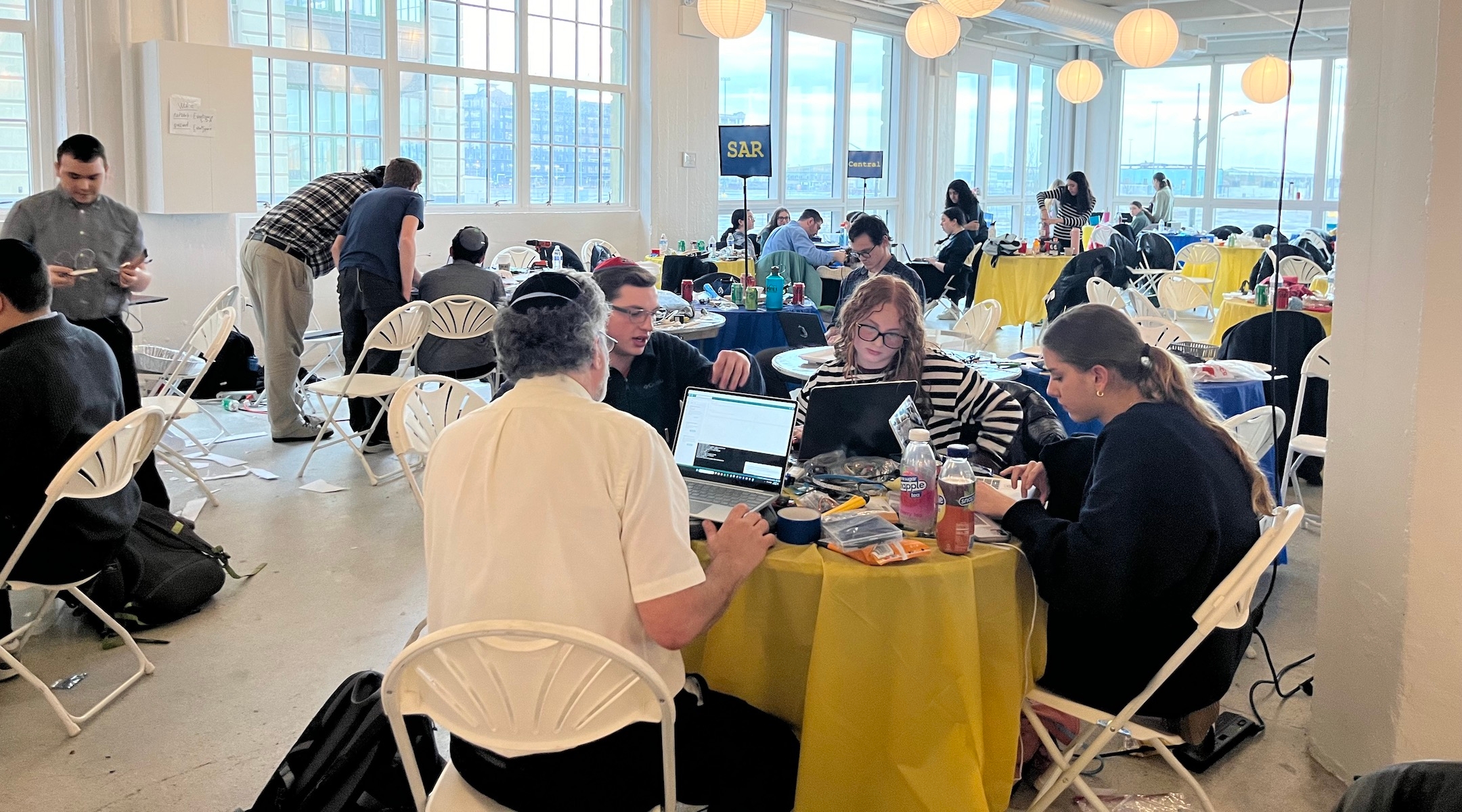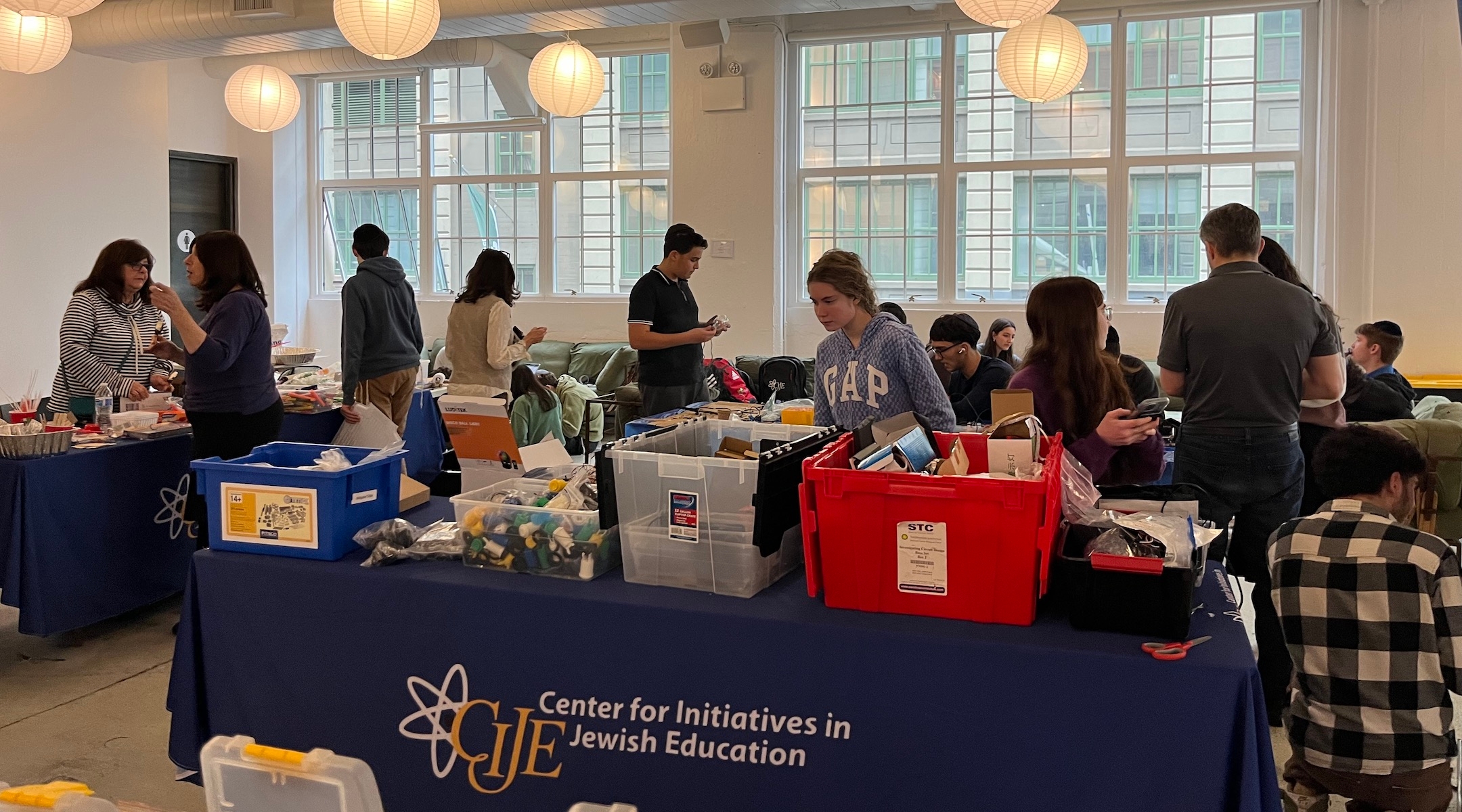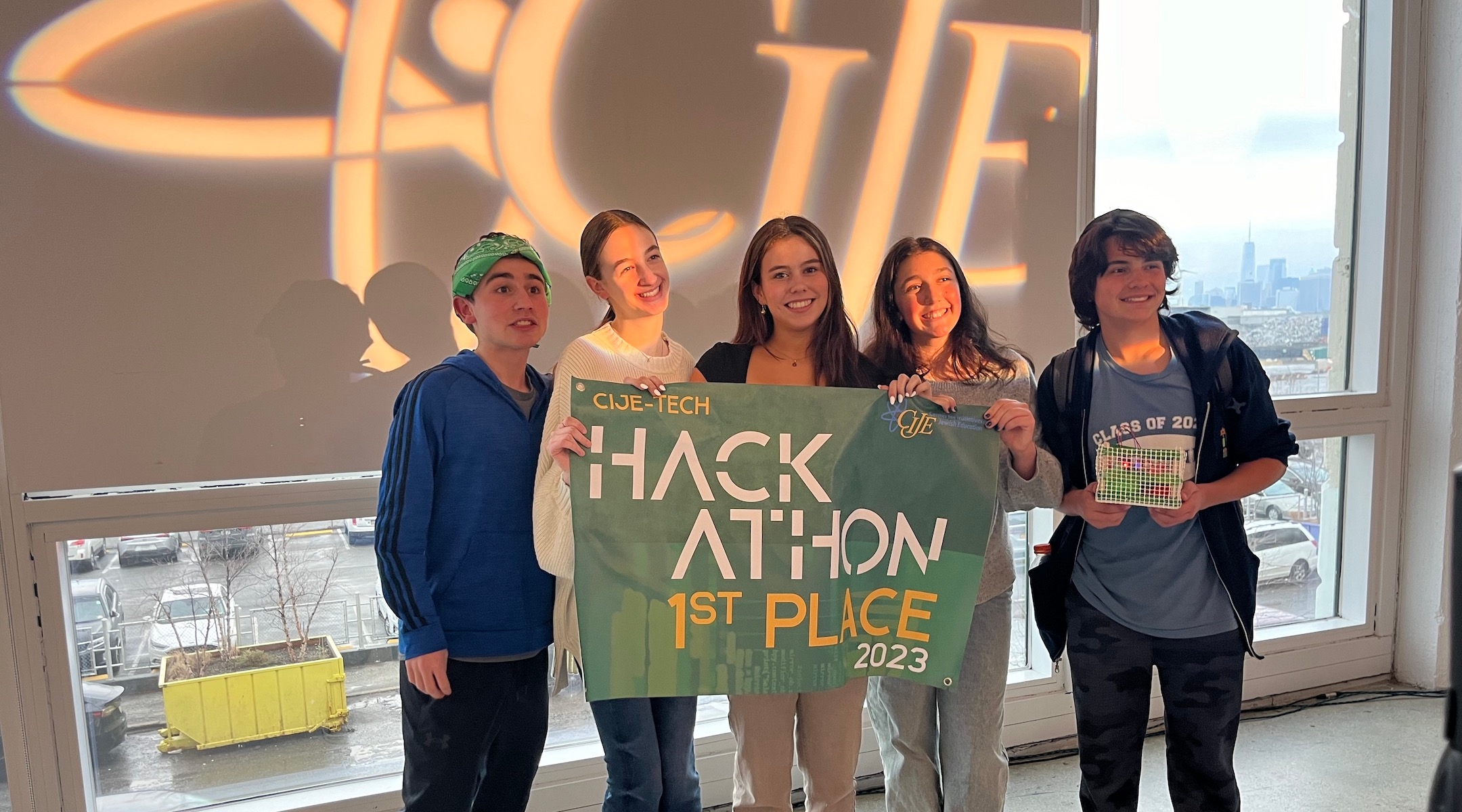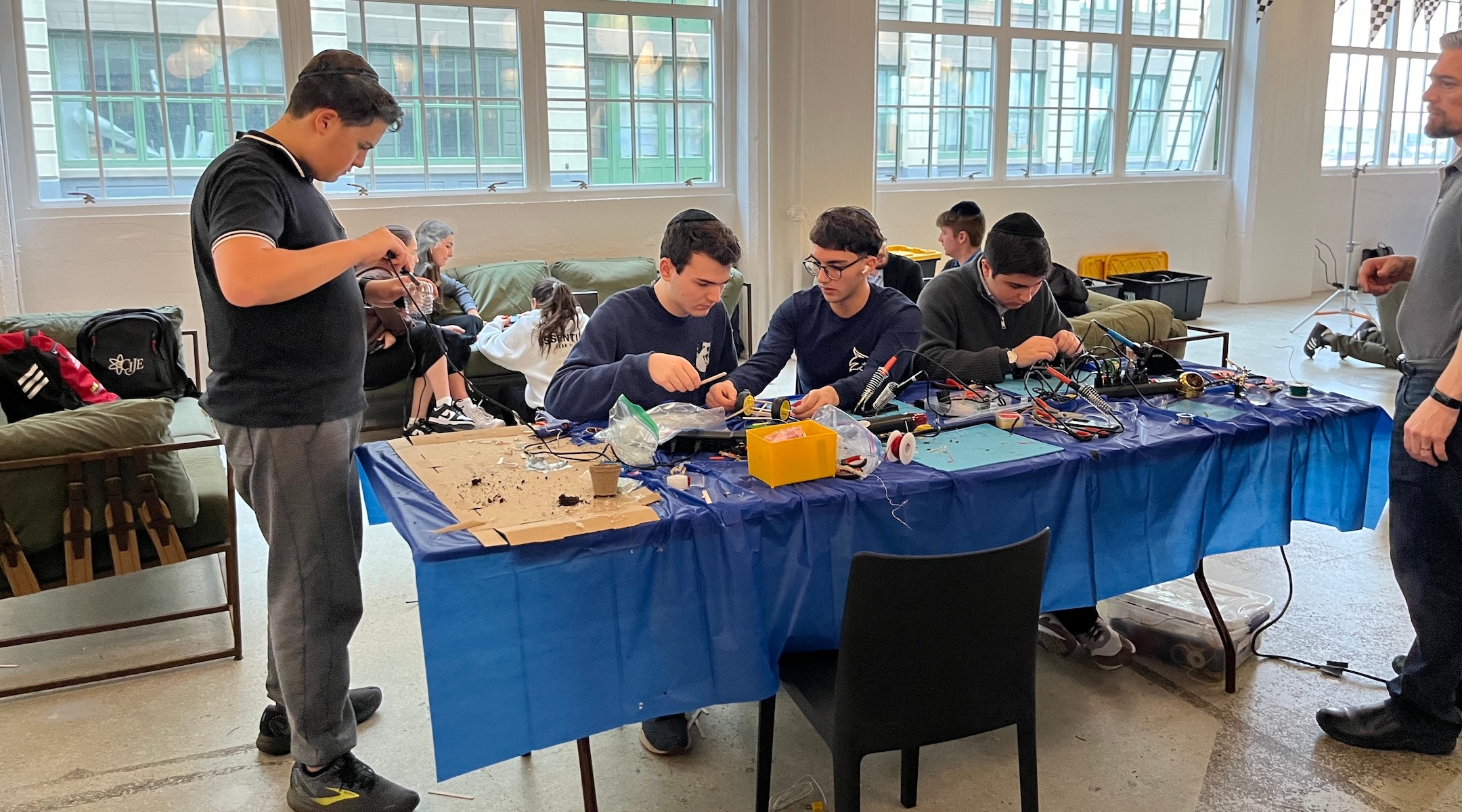(New York Jewish Week) — Kate Glick and Eliana Pell, friends and students at The Leffell School, a Jewish day school in Westchester, consider themselves budding engineers.
“In my engineering class at school, we code and we build circuits — I like to think about problems and solve them,” Glick, a tenth grader, told the New York Jewish Week.
Still, the pair didn’t know what to expect when they, along with three other classmates — Spencer Kolodny, Avery Brown and Alex Wigder — signed up for the Center for Initiatives in Jewish Education’s Hackathon. Sixteen other Jewish day schools competed in the annual engineering competition, which took place Wednesday in a warehouse across the street from CIJE’s headquarters at Industry City, a six million-square-foot mixed-use compound in Sunset Park, Brooklyn.
“I don’t even know what I was picturing,” Pell said, surveying the room bustling with 180 other students clustered at tables or sitting on couches working on their projects. “But it’s way more fun than I thought.”
CIJE began 15 years ago as a way to develop STEM curricula and events for kindergartners through 12 graders at more than 200 Jewish day schools across the country. “We saw the lack in the United States of STEM education, and even more so in our Jewish day schools, so we started these programs,” Philip Brazil, the organization’s vice president of development, said.
The Hackathon draws a diverse range of Jewish high schools in the Tri-State area, including Orthodox, single-gender schools like the all-girls Shevach High School in Kew Gardens Hills, Queens and Yeshiva University High School for Boys in Washington Heights, and co-ed community day schools like the Leffell School and the Bi-Cultural Hebrew Academy in Stamford, Connecticut.
The teams compete in engineering and coding competitions to create a solution for a real-world problem the Jewish community faces, or to try and solve a problem that Israeli start-ups are tackling themselves. In years past, teams have competed to find ways to improve nursing home conditions or optimize well usage in Africa.
This year, the students were tasked with aiding relief efforts in Israel following the deadly attack by Hamas on Oct. 7. To kick off this year’s Hackathon, the group heard a short presentation from the Israeli food bank Leket Israel about the work they do and the problems they’ve faced in recent months, including staffing shortages due, in part, to Israeli employees being called up to the reserves and Palestinian workers no longer able to cross the border.
Once the presentation ended, the teams had just over four hours to identify a specific Leket-related problem they wanted to solve, think of a solution and build a prototype. They also needed to code a website that would upload the results of their design.
The task seemed incredibly daunting to this English major, but the Leffell team was unfazed — in fact, all the groups were. Although the assignment was just given to the students that morning and they were all newbies — per the competition rules, schools couldn’t send students who had participated in the Hackathon before — they had all taken classes that were part of CIJE’s two-year engineering curriculum. In it they learned how to operate microprocessors, use sensors and controllers to measure data, as well as instantly upload data to a computer and code a website to display it.

Students work with teachers and CIJE advisors to develop, implement and code their ideas. (Julia Gergely)
Once the Leket presentation ended, the Leffell kids immediately jumped into action. “Our teacher told us, ‘Think about the problems, not the solution,’” Glick explained. “Like, think about what you’re trying to solve.”
A lucky coincidence, Glick had been in Israel the week before, volunteering for Leket. While she was there, she noticed the organization was stymied by excessive food waste. So Glick and her teammates determined that by measuring ethylene, the gas produced by ripening fruits and vegetables, Leket could better sort the food to be delivered along separate shipping routes — unripe fruits could travel longer distances, while the ripe or overripe fruits could stay closer.
Around the room, which has views of the New York Harbor and the Statue of Liberty, the other teams were engaging in the same sort of brainstorming and building processes. The teens cleverly combined old-school and new-school techniques — coders furiously typed at laptops while other group members hot glued their prototypes using materials like popsicle sticks and pipe cleaners, running back and forth to the “store,” a section at the back of the room that had buckets of electronics and building materials.

At the store in the back of the room, students have access to everything they need to put together their prototypes. (Julia Gergely)
“We’re not trying to make everyone into engineers,” Adam Jerozolim, CIJE’s director of curriculum development, explained. “It’s more of a concept of inspiring them to think, and STEM is the natural field to instill that in students.”
“They never get this in school, just telling them, ‘Use your imagination, use the skills you learned in class, make something, come up with an idea, build it, code it — it’s all you,’” he added.
Rifkie Silverman, the head of the engineering and computer science program at the Frisch School in Paramus, New Jersey, said the Hackathon is “fabulous.” Silverman has been bringing Frisch students since the competition began six years ago.
“It’s really exciting, it’s got great energy, seeing kids from other schools looking over and helping each other,” she said.
She added that the CIJE curriculum and the problems the students try to solve — with many taking inspiration from the outside world — is one of the most motivating parts of learning STEM at a Jewish school. “It’s a way to actually merge your passions,” Silverman said. “It’s so important to show them all the different ways that you can engage and contribute and really feel like you can make a difference.”
As the day approaches its end, the energy in the room grows considerably more harried. Some groups shriek when their prototypes falter, others race back to the “store” to grab materials for last-minute tweaks. Teachers and CIJE advisors float around the room, offering advice. Jerozolim, the curriculum director, is on the microphone, shouting out the amount of time remaining. With 50 minutes left, he says: “Start making your projects look like projects!” With 35, it’s,“Hot glue like you’ve never hot-glued before!”
Once time is up, each team has just three minutes to present their idea and do a test-run of their prototype. One school developed a bucket with a sensor that weighs the amount of food inside, assessing portion sizes and the amount of people it could feed to avoid waste. Another school developed a vehicle that would automatically till fields to compensate for the lack of farmworkers since Oct. 7. Other teams developed a machine that detects pests and another that automatically dispensed feed to farm animals.
In the end, however, the Leffell students’ idea to track the ripeness of produce led their team to victory. Earlier, Glick and Pell had joked that they were “Women in STEM”— a popular internet meme that plays on the stereotype of the predominance of men in the field — but they were palpably proud of what they achieved.

The Leffell Team: Spencer Kolodny, Kate Glick, Avery Brown, Eliana Pell, Alex Wigder. (Julia Gergely)
“It feels great — I was not expecting that at all,” Glick said. “It feels good that my education really meant something.”
The New York Jewish Week brings you the stories behind the headlines, keeping you connected to Jewish life in New York. Help sustain the reporting you trust by donating today.





